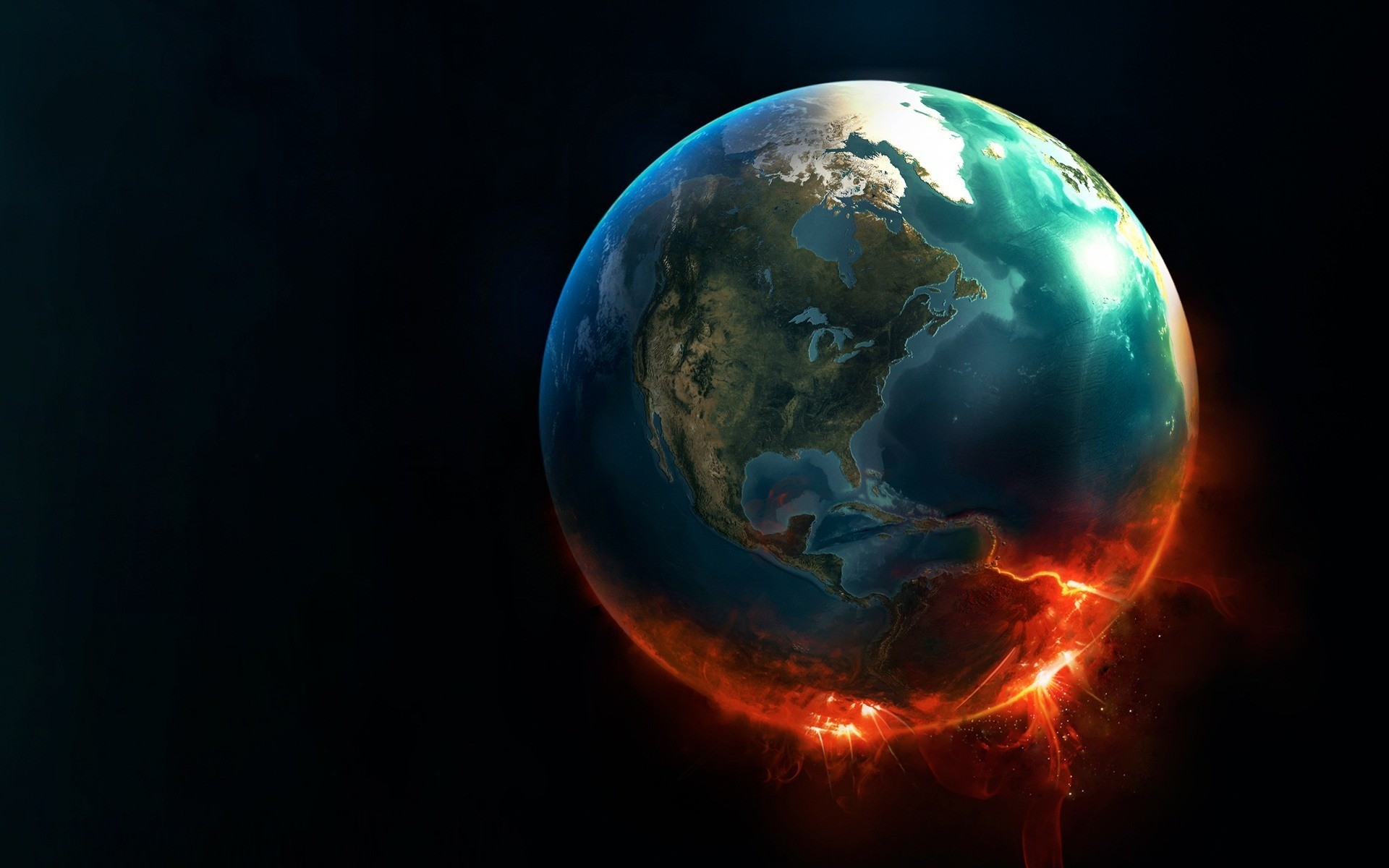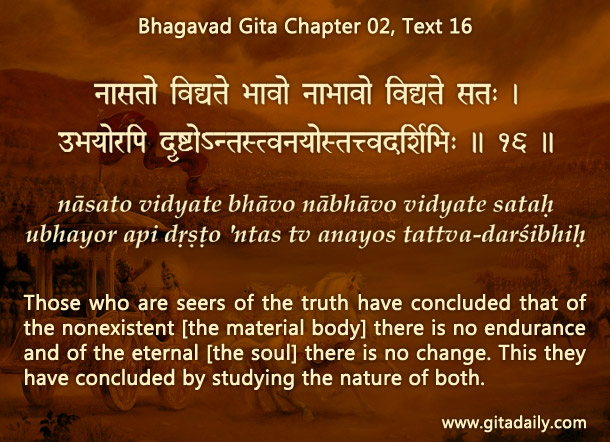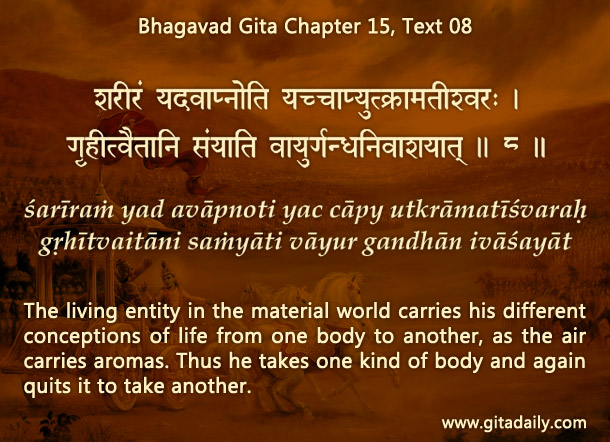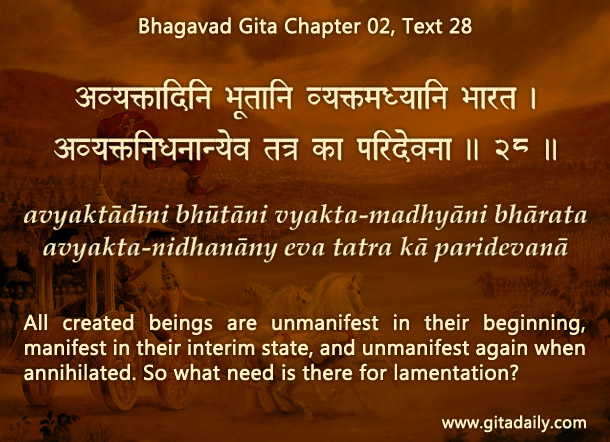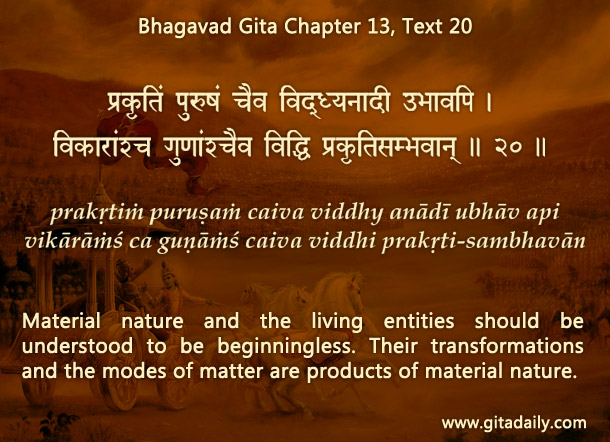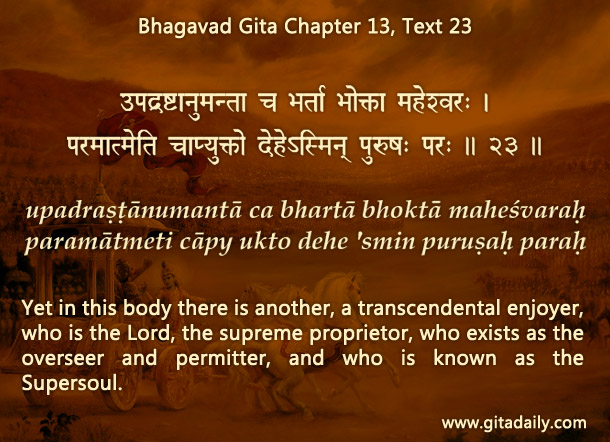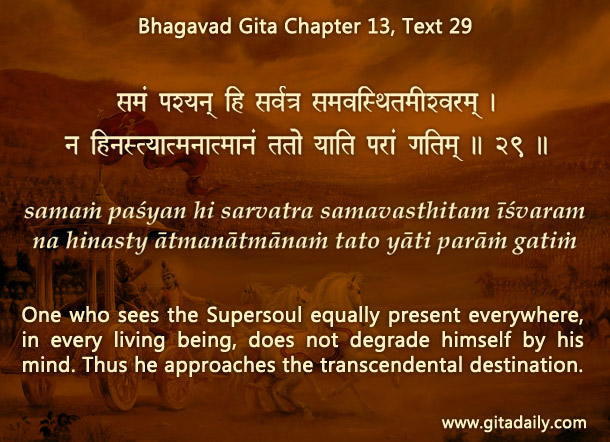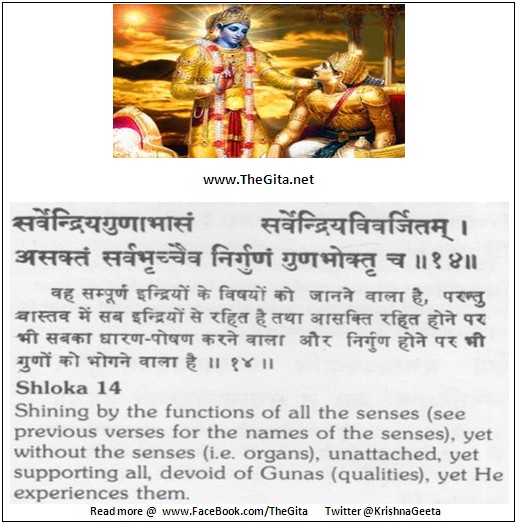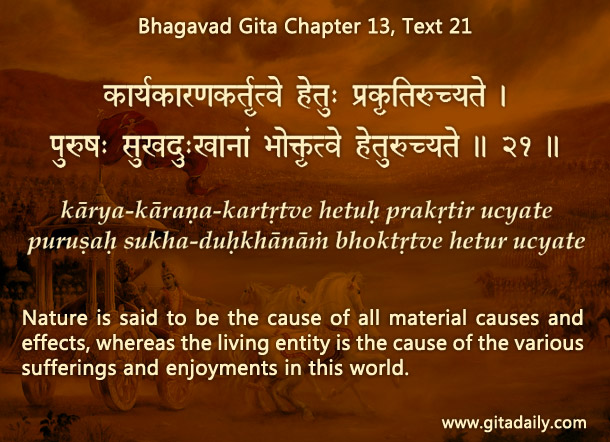| TRANSFORMING “I” INTO “I AM”
![Things are not what they seem, but they are not a dream | Article By ...]()
I am not aware of universal soul(other than God viewed as Unmanifest) that may pervade all creation. In the context of earthly living creatures, soul is concerned with giving ‘individuality’ to individual living things. The concept of soul helps me to make distinction between inanimate and animate, or nonliving and living. What we recognize as inert matter consists of chemical elements which always retain certain characteristics as if they are immutable, indestructible, immortal, eternal and even unborn. Animate matter is conscious where as inanimate lacks that functional ability. We use the term death or dying in respect of living creatures. It does not mean living matter is perishable. Living matter has same chemicals like carbon and nitrogen which we find in inert matter. None of the chemical elements of living matter experience any decay or deterioration; as such they are eternal. New life forms always need these nutrient chemical elements and death helps birth of new life. The term death or dying simply explains loss of morphological appearance of individual lifeforms. When soul departs, the living thing loses life supporting connection with Supersoul, the connection to access external source of energy. Without God Connection, living organism can no longer build, repair or breakdown molecules of life.
![Krishna’s purpose is not to catch us when we do wrong, but to catch ...]()
Life on this planet had a creative beginning and man just arrived as a new created object.
In my view, Shankara gave no explanation as to how “SELF” or “I” gets transformed into a living being that recognizes its own fact of existence and speaks as “I am.” I like the concept of “MAYA” but I account for it in a different way. I do not think Shankara had any insight about gravitational force.
Rudranarasimham Rebbapragada
On Saturday, February 27, 2016 4:25 AM, Devinder Singh Gulati wrote:
| >>>. I cannot separate man into soul and supersoul. They have to remain together; there is no reality called man without that unity.
That as the very same position as Rawel Singh. To him the spirit pervades all of manifestation, all creatures and all space. He cannot conceive of a separate soul for each creature. What is this position in terms of the six philosophical positions?
It is not Sankhya and not Yoga philosophy.
It is not Bheda- Abheda that says Brahman converts itself into the created, but yet maintains a distinct identity. Thus, the school holds that Brahman is both different (bheda) and not different (abheda) from creation and the individual jīva.
It is also not Vishistadvaita and not Dvaita.
It is Shankar’s advait with one part missing.
Śaṅkara’s philosophy and criticism of common sense rests on an argument unique to him in the history of Indian philosophy—an argument that Śaṅkara sets at the outset of his commentary on the Brahma Sūtra. From this argument from superimposition, the ordinary human psyche (which self identifies with a body, a unique personal history, and distinguishes itself from a plurality of other persons and objects) comes about by an erroneous superimposition of the characteristics of subjectivity (consciousness, or the sense of being a witness), with the category of objects (which includes the characteristics of having a body, existing at a certain time and place and being numerically distinct from other objects). According to Śaṅkara, these categories are opposed to each other as night and day. And hence, the conflation of the two categories is fallacious. However, it is also a creative mistake. As a result of this superimposition, the jīva (individual person) is constructed complete with psychological integrity, and a natural relationship with a body (Śaṅkara Brahma Sūtra Bhāṣya, Preamble to I.i.1). All of this is brought about by beginningless nescience (avidyā)—a creative factor at play in the creation of the cosmos.
In reality, all there really is on Śaṅkara’s account is Brahman: objects of its awareness, such as the entire universe, exist within the realm of its consciousness. The liberation of the individual jīva occurs when it undoes the error of superimposition, and no longer identifies itself with a body, or a particular person with a natural history, but with Brahman.
http://www.iep.utm.edu/hindu-ph/#H2
On Śaṅkara’s account, there is a lower and higher self. The lower self is the jīva, while the higher self (the real referent of the personal pronoun “I,” used by anyone) is the one real Self: Ātma, which on Śaṅkara’ s account is Brahman.
The missing part is this:
Likewise, on Śaṅkara’s account, there is a lower and a higher Brahman (Śaṅkara Brahma Sūtra Bhāṣya IV.3.16. pp. 403-4). The lower Brahman is the personal God that pious devotees pray to and meditate on, while the Higher Brahman is devoid of most all such qualities, is impersonal, and is characterized as being essentially bliss (ānanda) (Śaṅkara Brahma Sūtra Bhāṣya III.3.14) truth (satyam) knowledge (jñānam) and infinite (anantam) (cf. Śaṅkara, Taittitrīya Upaniṣad Bhāṣya II.i.1.). The lower Brahman, or the personal God that people pray to, can be afforded the title of “Brahman” owing to its proximity to the Highest Brahman: in the world of plurality, it is the closest thing to the Ultimate (Śaṅkara Brahma Sūtra Bhāṣya IV.3.9). However, it too, like the concept of the individual person, is a result of the error of superimposing the qualities of objectivity and subjectivity on each other (Śaṅkara, Brahma Sūtra Bhāṣya IV.3.10). In the Advaita tradition, the lower Brahman is known as the saguṇa Brahman (or Brahman with qualities) while the highest Brahman is known as the nirguṇa Brahman (or Brahman without qualities) (Śaṅkara Brahma Sūtra Bhāṣya III.2.21).
Now Guru Nanak’s philosophy is of a sagun braham. Moreover since Shankara thinks the world is illusion, this cannot be Naank’s phisophy what Rawel Singh believes.
What are your points of difference with Shankara Rudra? |
From: Devinder Singh Gulati
Atma and paramatma are used synonymously in the Gita. What you mean by atma is perhaps answered by Jivatma of the Gita.
Regarding relationships between senses and material nature see chapter Xlll verses 12 to 15
” The supreme Brahma, who is the lord of the two beginningless entities – Prakrti and Jiva is said to be neither Sat (being) nor As at (non-being)
[Text12-chapt. 13]
It has hands and feet on all sides, eyes, head and mouth in all directions, and ears all round; for it stands pervading all in the universe. [Text 13 chapter 13]
Though perceiving all sense-objects, it is really speaking devoid of all senses. Nay, though unattached, it is the sustainer of all nonetheless; and though attribute less, it is the enjoiyer of the Gunas the three modes of Prakrti. [Text 14 – 14]
It exists without and within all beings, and constitutes the moving and unmoving creation as well. And by reason of its subtlety, it is incomprehensible; it is close at hand and stands afar too. [Text15 – 14 as translated by Gita Press, Gorakhpur].Now juxtapose this against Daljeet Singh’s description of Naam:
(i) ‘Naam sustains all regions and universes, all thought, knowledge and consciousness, all skies and stars, all forces and substances, all continents and spheres. Naam emancipates those who accept it in their heart. He, on whom is His Grace, is yoked to Naam and he reaches the highest state of development.’2
(ii) ‘Naam is the Creator of everything. To be divorced from Naam is death.’3 ‘All is created by Naam.’4 ‘Naam gives form to everything and through Naam comes all Wisdom or Light.’5
(iii) ‘Naam extends to all creation. There is no place or space where Naam is not.’6
(iv) Naam is the ‘Nine Treasures’ and Nectar (amrita). It permeates the body.’7
(v) ‘Naam, the immaculate, is unfathomable, how can it be known ? Naam is within us, how to get to it ? It is Naam that works everywhere and permeates all space. The perfect Guru awakens your heart to the vision of Naam. It is by the Grace of God that one meets such an Enlightener.’8
http://sikhinstitute.org/essential/ch3.html
The supreme Brahma, neither being nor non-being seems to me to allude to pure existence. The beginningless Prakrti and Jiva, being above the manifestation of Gunas, to unconditioned existence. These are both beings and hence a different status from the pure existence.
Is Naam merely the immanence of God? ‘All is created by Naam.’ Naam is also above creation and hence transcendent to it. It is the beginningless Prakrti, the parashakti of the Gita.
“Though perceiving all sense-objects, it is really speaking devoid of all senses. Nay, though unattached, it is the sustainer of all nonetheless; “
And though attribute less, it is the enjoiyer of the Gunas the three modes of Prakrti. The enjoyer is a person always so this refers to Prakrti not the supreme Brahma. Naam as creator should be synonymous with beginningless Prakrti. |
From: R.Rudranarasimham
| Kshetra – Kshetrajna Vibhaga Yoga, Bhagavad Gita, Chapter XIII
![Things are not what they seem, but they are not a dream]()
![The vision of the one in everyone grants liberation | Article By ...]()
![The Gita – Shree Krishna Bhagwad Geeta]()
Thanks for your kind response. I enjoy reading your posts but find it difficult to respond as you move from issue to another rather quickly. I have not studied Sikh scriptures and I have not studied Aurobindo. I am forced to respond to your statements in the context that you present. I can understand terms like existence and conditioned or unconditioned existence, but fail to understand terms like ‘Pure Existence’.
While Shankara described perfect identity between Atma and Paramatma, I am not able to support that view. If you think that I follow doctrine of ‘Monism’, I describe unity between Atma and Paramatma while they are distinct or separate. I do not totally embrace doctrine of ‘Dualism’ for I have to account for this yoking, coming together, joining, pairing, relationship, partnership, and association between two entities. The result of this unity, or the consequence of this connection is that of singular effect. When you taste Salt, the sensation imparted is most important singular effect. A proponent of Dualism may prove that Salt consists of two entirely different chemical elements but that reality cannot account for the effect caused by their coming together. Man can never discern taste of Sodium or Chlorine while tasting Salt. In terms of human existence, this pairing or yoking is the most significant effect and there is no entity called man when the two become unstuck. I can separate Salt into Sodium and Chlorine, but I cannot separate man into soul and supersoul. They have to remain together; there is no reality called man without that unity.
Verse 14, Chapter XIII, Bhagavad Gita describes complex nature of relationships between senses and material nature. Supersoul is completely ‘unattached'(“asaktam”, or ‘Udasin’), yet the Sustainer of everything; transcendental to material nature yet the Maintainer of material nature.
![The world determines our situations, but we determine our situations ...]()
![Bhagavad Gita As It Is – Chapter Thirteen - His Holiness Krishna ...]()
All said and done, we can still discuss man and his world using verified information that is currently available and relate it to various doctrines.
Rudranarasimham Rebbapragada
On Thursday, February 25, 2016 12:00 AM, Devinder Singh Gulati wrote:
| I am glad to see your post Rudra. On this issue, you and l are on the same side of the argument, though not on the issue of the primary substance that is the basis of of our respective monisms. I am not sure what your position is on advaita that one God of infinite possibility.
I now see why you formulate the issue as you do: “The issue is not that of how many different Gods man may choose to worship. The problem is not that of proving existence of one and only one God. The problem is creation and created objects. Each created object exists as one of its own kind of original object, that never existed before, and will never exist agian in future. Each man differs from all other men who currently exist in world apart from differing from all men who existed in the past, or may come into existence in future.”
Yours is a mathematical formulation of the one vs the infinite and hence your objection to having the cake and eating it too.
I have been putting it to Rawel Singh, HARDEV Singh, and Rabinder Bhamraji that their formulation of a monotheist God in Sikhism is inconsistent with the monist God of infinite possibility that is the stated position of advaita and other systems of Indian thought: “There are several forms of Indian philosophy which base themselves upon the One Reality, but they admit also the reality of the world, the reality of the Many, the reality of the differences of the Many as well as the sameness of the One (bheddbhedd). But the Many exist in the One and by the One, the differences are variations in manifestation of that which is fundamentally ever the same. This we actually see as the universal law of existence where oneness is always the basis with an endless multiplicity and difference in the oneness.”
Now you assume ONE to be finite, but Indian thought consistently posits it as infinite. How do you reconcile that?
Sikh thought has components not only of the advait monism but also of the sankhya system: “Prakriti, or Nature, is the material principle of the cosmos and is comprised of three gunas, or “qualities.” These are sattva, rajas, and tamas. Sattva is illuminating, buoyant and a source of pleasure; rajas is actuating, propelling and a source of pain; tamas is still, enveloping and a source of indifference (Sāṅkhya Kārikā 12-13).
Purusa, in contrast, has the quality of consciousness. It is the entity that the personal pronoun “I” actually refers to. It is eternally distinct from Nature, but it enters into complex configurations of Nature (biological bodies) in order to experience and to have knowledge. According to the Sānkhya tradition, mind, mentality, intellect or Mahat (the Great one) is not a part of the Purusa, but the result of the complex organization of matter, or the gunas. Mentality is the closest thing in Nature to Purusa, but it is still a natural entity, rooted in materiality.”
But the purusa of the sankhya system is not the purakh of Sikhism. Rather it is the Karta purakh of the yoga system that is the active agent of creation in Sikhism. So Rawel Singh would do well to study the Sankhya philosophy, the Yoga philosophy and the Vedanta philosophy to understand Sikhism.
Within the Vedanta philosophy elements of vishistadvata are in evidence in Sikhism as brought out in the Daljeet Singh article that was referenced earlier where a key concept of vishistadvaita is highlighted. What is this concept of vishistadvata: “The organismic aspect of Rāmānuja’s model consists in his view that all things that we normally consider as distinct from Brahman (such as individual persons or jīvas, mundane objects, and other unexalted qualities) constitute the Body of Brahman, while the Ātman spoken of in the Upanisads is the non-body, or mental component of Brahman. The result is a metaphysic that regards Brahman as the only substance, but yet affirms the existence of a plurality of abstract and concrete objects as the qualities of Brahman’s Body and Soul (Vedārthasaṅgraha §2).
http://www.iep.utm.edu/hindu-ph/
You assume advaitic thought to be identical with Sankara’s advaita, Rudra. Although the advaitic experience of Guru Nanak was the same as Shankar’s, the two reached diametrically opposite conclusions regarding the reality of the world. This is because Shankar’s had the experience in the nirgun (pure existence) aspect, Guru Nanak had it in its sargun aspect ( existence in which will to create -called has manifested). “We have said, however, that personality and impersonality, as our minds understand them, are only aspects of the Divine and both are contained in his being; they are one thing which we see from two opposite sides and into which we enter by two gates. “
The difference of the two experiences was explained in an earlier post thus: ” The “pure Existence” is nirguna. Here there is not yet Sat, the consciousness of existence and Chit-shakti, or consciousness force.
Sri Aurobindo says further “It is already indicated in the Gita’s teaching of the Purushottama and the Parashakti (Adya Shakti) who become the Jiva [Purushottaama becomes Jiva] and uphold [Parashakti upholds] the universe. It is evident that Purushottama and Parashakti are both eternal and are inseparable and one in being; the Parashakti manifests the universe, manifests too the Divine in the universe as the Ishwara and Herself appears at His side as the Ishwari Shakti. Or, we may say, it is the Supreme Conscious Power of the Supreme that manifests or puts forth itself as Ishwara Ishwari, Atma Atma-shakti, Purusha Prakriti, Jiva Jagat. That is the truth in its completeness as far as the mind can formulate it. In the super-mind these questions do not even arise: for it is the mind that creates the problem by creating oppositions between aspects of the Divine which are not really opposed to each other but are one and inseparable.
Thus Jiva, our individual existence is simultaneous with Purushottama who is to be distinguished from lshwara of the apara prakriti. “
The parashakti of the Gita that Sri Aurobindo is alluding to, is same as the Naam of Guru Nanak. |
From: R.Rudranarasimham
| CAN’T HAVE CAKE AND EAT IT TOO
![You can't have your cake and eat it too Picture Quote #1]()
Are you fully satisfied with your interpretation of philosophical doctrine of Sikhism? In my analysis ‘Monotheism’, belief or doctrine that there is only ‘ONE'(“1”) God is not consistent with God who is ‘Infinite’, lacking limits or bounds, extending beyond measure or comprehension. The concept of ‘Infinite’ demands existence of something greater than any ‘finite’ number. In Mathematical Science infinite refers to indefinitely large. The doctrine of ‘ONE’ God can be easily contested by a doctrine that may claim existence of two or more Gods. When God is viewed as ‘Infinite’ or ‘Ananta’, there is no other ‘finite’ number greater than what is stated as ‘Infinite’. Number 1 is not compatible with mathematical concept of ‘Infinite’.
We have other religions that proclaim ‘One God’ doctrine. Where do these Gods of Monotheism exist? Do they share a common Heaven? Do they even know each other? Do they speak same language? Is there any correspondence between the theory and reality of world? You have to make just one claim to give clarity to your doctrine. The belief in ‘One God’ has not saved Sikhs from persecution by others who believe in same theory. It won’t save you in future.
Rudranarasimham Rebbapragada
On Wednesday, February 24, 2016 1:21 AM, Devinder Singh Gulati wrote:
Sikhism affirms both. That God is one. Thet God is infinite.
Here is what a Sikh writer says:
The Gurus repeatedly emphasize that He is One and we only give Him different names. But it would be highly inappropriate to confuse the Gurus’ concept of sargun and nirgun (i.e. One Transcendent cum Immanent God) with the Advaitic connotation o these terms as also of Ishvara. These Advaitic concepts have distinct connotation of phases, stages or transformation. These have been clearly repudiated by the Gurus by their concept of One God. Shankra deems Ishvara to be a lower stage of God which has to be transcended to reach the higher stage of Brahm. For Ramanuj a God is virtually pantheistic. The world, souls and Ishvara are three eternal principles. The world and souls are the body and qualities of Brahm. The three eternal principles of Ishvara, souls and the world constitute the Brahm, which is an entirely different concept from that of the One Creator, God of the Gurus, who is simultaneously Transcendent, Immanent and Everything. The Gurus never accept the Advaitic concepts of sargun and nirgun. Similarly in the hymn of Sach khand, the Guru calls the nirankar as One who resides, deliberates, creates and directs. He is Benevolent, Gracious and is delighted to see His Creation. But nirankar literally means the “Formless One” and similarly, has distinct Advaitic meanings. The hymn referred to above repudiates all those concepts and adds that Sach khand, the abode of God, is full of endless numbers of forms, universes and regions. [ Daljeet Singh: The concept of God]It is possible this idea flows from inadequate reading of the Guru Granth saheb or misunderstanding of advaitic concepts of Hinduism.
In another article Daljit Singh writes:
http://hinduwebsite.com/sikhism/the-idea-of-god-in-sikhism.asp |
From: R.Rudranarasimham
| GOD IS INFINITE BEING
![The Incommunicable Attributes of God: God is Infinite | Shayna George]()
I have yet to understand your basic presumption about philosophy of Sikhism. We have three schools of Indian Thought founded by Shankara, Ramanuja, and Madhva. I agree and disagree with all of them. In your case, I cannot perform similar analysis to find accuracy and consistency by comparing your view to an external reality. I need to hear from others who studied Sikhism and interpret its philosophy. If there is any given statement attributed to Sikhism, I have to know as to how it is interpreted by two different readers of the same statement. When you add too much detail, it causes confusion. Firstly, I have to know if Sikhism supports the doctrine called ‘Monotheism’, the doctrine about ‘One God’. Is this the same doctrine shared by ‘Islam’??? If the doctrines are same, I have to reconcile it with the fact of execution of Sikh Gurus and their followers by Mughals who claimed belief in ‘One God’.
![An infinite God . . . . A.W. Tozer quote | sayings | Pinterest]()
In Indian tradition, God is ‘Infinite’, or ‘ANANT’ which means limitless or endless in space, extent, or size, impossible to measure or calculate. There are several terms that convey similar meaning; boundless, unbounded, unlimited, limitless, never-ending, interminable, immeasurable, uncountable, inestimable, innumerable, numberless, incalculable, untold, myriad, and countless.
![The infinity of God is not mysterious, it is only unfathomable; not ...]()
Kindly tell me as to which of the following statements represents God as defined by Sikhism:
1. God is ONE.
2. God is INFINITE.
Rudranarasimham Rebbapragada
On Tuesday, February 23, 2016 2:44 AM, Devinder Singh Gulati wrote:
Rudra: l don’t see the connection you make between monotheism and ‘unique physical being’. The problem of monotheism to me remains the separation or non separation of two principles permanently. In the first case it is dualism, in the second a unity – as in the monism of advait.
Your entire approach is from the lower end monism of matter, my explanations are from the higher end monism of spirit, which is also self-existent consciousness. In your approach it is derived consciousness or observed consciousness.But some scientists have been able to put out theories without observations, simply ideating it. This scientist was able to access the blueprint of human physiology from the pure mental world of ideas where it resides – not from observation an classification and derivation:
“One person who thought differently, though, was the Danish scientist Nils Jerne – a brilliant thinker who had little interest in carrying out experiments. In 1955, he published his hypothesis – that at birth, the body has already created all the antibodies it is ever likely to need. He proposed instead that when the body encounters a new invader, it scans its ‘catalogue’ of antibodies and selects the correct one to deploy for the task of defeating it.
http://www.nobelprize.org/educational/medicine/immuneresponses/overview/
The ‘self-molecule’ that you refer to does not denote individuality to me in the sense of ‘person’. No doubt it is individual in the sense that it is distinct, but individuality here is part of ‘personality’ not ‘person’.
The ‘person’, such as purush in sankhya is a person that throws out infinite personalities in nature. The self-molecule is a functional aspect of putting out a distinct body associated with a distinct personality – just one of the many infinite personalities – that is to be realised in nature.
The purush of the yoga system is a ‘Karta purakh’, (as in Sikhism), as apposed to inactive purakh of the Sankya system where nature is the active agent.
Thus self-molecule is function of nature directed at expressing individual personality that is one of the infinite personalities that the true person; Jivatma, those out in the course of its self expression in nature.
The centre of identification is always the person, never the personality.
“We can experience our central or true being as a kind of vertical axis at the core of our being. Above all the planes and worlds, it is the jivatman, who eternally and immutably presides over our nature. On the lower levels, it is our psychic being (antaratman, chaitya purusha) who has descended, as the delegate of our eternal Self, into the “world of becoming.” Sri Aurobindo uses the word “Self” for our transcendent, immutable essence, both in its universal form (paramatman, atma), and in its individual form (jivatman). He uses “Self” also as the translation of “purusha”, the center of our conscious existence on any level.
Sri Aurobindo uses the word “soul” for our evolving, psychic center. Initially this psychic center is only a small, almost point-like psychic entity, of which one can feel at best a psychic influence. Gradually, as it brings more of the nature under its influence, it becomes a full-fledged psychic being, which one can feel as a psychic presence.
The true being may be realized in one or both of two aspects — the Self or Atman and the soul or antaratman, psychic being, chaitya purusha. The difference is that one is felt as universal, the other as individual supporting the mind, life, and body. When one first realizes the Atman one feels it separate from all things, existing in itself and detached. When one realizes the psychic being, it is not like that; for this brings the sense of union with the Divine and dependence upon It and sole consecration to the Divine alone and the power to change the nature and discover the true mental, the true vital, the true physical being in oneself. Both realisations are necessary for this yoga.
(Sri Aurobindo, Letters on Yoga, p. 277).
http://www.ipi.org.in/texts/matthijs/mc-selfandpersonality-sp.php |
From: R.Rudranarasimham
| DEFENDING EXISTENCE – MOLECULAR INDIVIDUALISM
![Figure 1. The Immune System and White Blood Cells]()
The doctrine called ‘Monotheism’ is fundamentally flawed for man’s individuality is defined by unique molecules. I am asking you to defend your theory called ‘Monotheism’. Something can be said to be true if it is attached with a reason as to why it is true. Kindly take some time to explore the concept of ‘Molecular Individualism’.
![Blog Archive FOLLOWING COURSE ABOUT ADVANCED IMMUNOLOGY -]()
Rudranarasimham Rebbapragada
|
|
|
|
|
|


